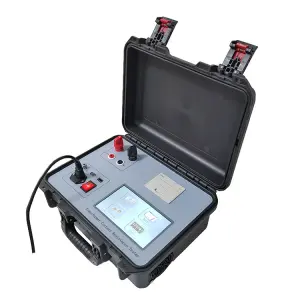One way that can be used to check the electrical connections and insulation’s condition is by using the contact resistance test or the Megger test. However, even though they are both electrical tests, they serve different purposes and measure different parameters.
Here are the main variations between these two types of testing methods:
- Contact Resistance Test:
- Purpose: The contact resistance test, also known as the low-resistance ohmmeter (LRO) test or micro-ohmmeter test, is primarily used to measure the resistance of electrical connections, such as bolted joints, busbars, circuit breakers, switches, and other high-current-carrying components.
- Measurement Principle: The test measures the resistance between two conductive surfaces or contacts to assess the quality of the electrical connection. It typically involves passing a known current through the connection and measuring the voltage drop across it to calculate the resistance using Ohm’s law.
- Equipment: Specialized low-resistance ohmmeters or micro-ohmmeters are used for contact resistance testing. These instruments are capable of accurately measuring very low resistances in the milliohm or microohm range.
- Applications: Contact resistance testing is commonly performed during commissioning, maintenance, or troubleshooting of electrical equipment to identify loose connections, corrosion, or other issues that could lead to overheating, voltage drop, or equipment failure.
- Megger Test (Insulation Resistance Test):
- Purpose: The Megger test, officially known as the insulation resistance test, is used to assess the insulation resistance of electrical insulation materials, such as wires, cables, transformers, motors, and other electrical equipment.
- Measurement Principle: The test measures the resistance between two points of an electrical circuit to ground to evaluate the integrity of the insulation. It typically involves applying a high-voltage DC test voltage to the insulation and measuring the resulting leakage current.
- Equipment: The Megger test is conducted using a specialized instrument called a Megohmmeter or Megger, which is capable of applying high-voltage DC test voltages (often in the range of 500V to several kilovolts) and measuring high resistance values in the megohm range.
- Applications: The Megger test is commonly used for insulation resistance testing during installation, maintenance, or periodic testing of electrical equipment to detect insulation degradation, moisture ingress, or other insulation faults that could lead to electrical leakage or breakdown.
To sum up, the contact resistance and Megger tests both are electrical tests that are used for evaluating electrical connections and insulation status. However, they emphasize on different aspects – resistance in connections as opposed to that in insulations, besides serving dissimilar aims – appraising electric links vis-a-vis assaying insulating material soundness. The two serve as crucial instruments for electro-mechanical maintenance technicians, who are involved in solving problems related to electricity; they also help in guaranteeing safety, as well as dependability of electric appliances and power systems.
